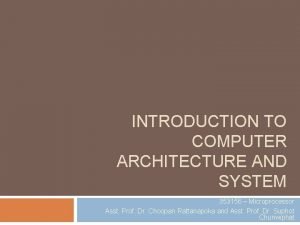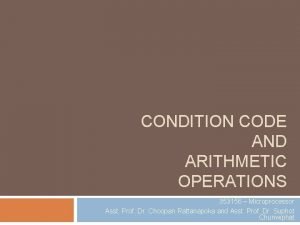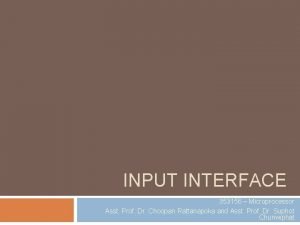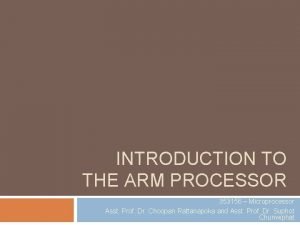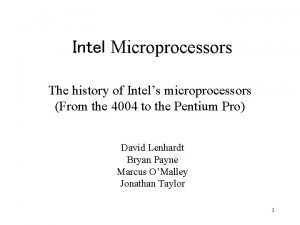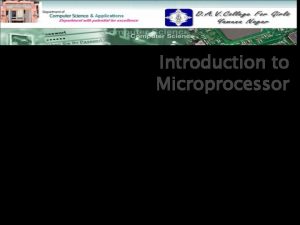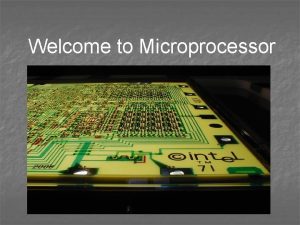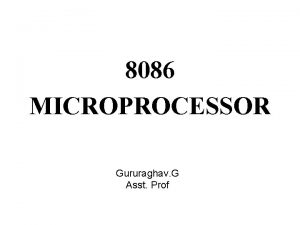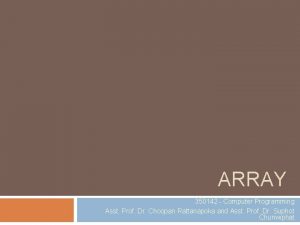OUTPUT INTERFACE 353156 Microprocessor Asst Prof Dr Choopan

















- Slides: 17

OUTPUT INTERFACE 353156 – Microprocessor Asst. Prof. Dr. Choopan Rattanapoka and Asst. Prof. Dr. Suphot Chunwiphat

ARM Memory Structure AHB = Advanced High-Performance Bus � Start at memory address 0 x. F 0000 APB = Advanced Peripheral Bus � Start at memory address 0 x. E 0000 Memory access also reading/ writing a sequence of bytes, so use loads for input, stores for output • Called “Memory Mapped Input/Output” • A portion of the address space dedicated to communication paths to Input or Output devices (no memory there)

GPIO (General Purpose Input/Output) We can use GPIO as an Input or an Output port � Input : input digital/analog signal to Microprocessor � Output : digital output signal to devices. IN ARM 7 � 2 legacy ports (Port 0, Port 1) � Each port has 32 pins (P 0. 4 means Port 0 pin 4)

LPC 2388 Board

LPC 2388 Board (Available Port) Port 0 � P 0. 0, P 0. 1 (2 pins continuous) � P 0. 4 – P 0. 9 (6 pins continuous) � P 0. 12 – P 0. 18 (7 pins continuous) � P 0. 24 – P 0. 31 (8 pins continuous) Port 1 � P 1. 19 – P 1. 31 (13 pins continuous)

Control Register on GPIO Port There are 4 abstract registers to control GPIO port � IODIR (GPIO Port Direction Control Register) To control either GPIO port is an input port (0) or output port(1) We use IODIR 0 for Port 0, and IODIR 1 for Port 1 � IOPIN (GPIO Pin Value Register) To read current port status We use IOPIN 0 for Port 0, and IOPIN 1 for Port 1 � IOSET (GPIO Port Output Set Register) To write data “ 1” to the specific port to make output logic to “ 1” IOSET 0 for Port 0, and IOSET 1 for Port 1 � IOCLR (GPIO Port Output Clear Register) To write data “ 1” to the specific port to make output logic to

Example 1 : Setting a port as output unsigned int P 0_9 = 0 x 00000100; IODIR 0 = P 0_9; Define a variable P 0_9 to store value 0 x 00000100 Set Port 0. 9 as an output port IOSET 0 = P 0_9; Set logic “ 1” as output of Port 0. 9 IOCLR 0 = P 0_9; Set logic “ 0” as output of Port 0. 9

Example: 2 LEDs Blink (1) 2 LEDs � connected to P 0. 29 � connected to P 0. 30 We want 2 LEDs blink at the same time.

Example: 2 LEDs Blink (2) #include “LPC 23 XX. h” int main(void) { unsigned int P 0_29 = (1 << 29); unsigned int P 0_30 = (1 << 30); int i; IODIR 0 = P 0_29 | P 0_30; while(1) { IOSET 0 = P 0_29 | P 0_30; for(i = 0; i < 10000; i++); IOCLR 0 = P 0_29 | P 0_30; for(i = 0; i < 10000; i++) } }

Example 3: 7 -Segment (1) Suppose, we use common cathode 7 -segment � Logic 1 at either a, b, c, d, e, f, g or dp will light up that LED. We will use P 1. 31 for a � P 1. 30 for b � P 1. 29 for c � P 1. 28 for d � P 1. 27 for e � P 1. 26 for f � P 1. 25 for g � P 1. 24 for dp �

Example 3: 7 -Segment(2) Displa y P 1. 31 (a) P 1. 30 (b) P 1. 29 (c) P 1. 28 (d) P 1. 27 (e) P 1. 26 (f) P 1. 25 (g) P 1. 24 (. ) 0 1 1 1 0 0 0 x. FC 000000 1 1 0 0 0 x 60000000 2 3 4 5 6 7 8 9. Let’s complete the table Hex Value

Example 3 : 7 -Segment (3) Code for displaying “ 0” on 7 -segment. #include “LPC 23 XX. h” int main(void) { unsigned int P 1_24 TO 31 = 0 x. FF 000000; IODIR 1 = P 1_24 TO 31; IOCLR 1 = P 1_24 TO 31; IOSET 1 = 0 x. FC 000000; while(1); }

SWITCH-CASE in C is used for selecting a multiple (constant) choices.

Example : SWITCH-CASE

Example : SWITCH-CASE with Break

Example : 7 -Segment with SWITCH #include “LPC 23 XX. h” int main(void) { unsigned int P 1_24 TO 31 = 0 x. FF 000000; int num = 0; IODIR 1 = P 1_24 TO 31; IOCLR 1 = P 1_24 TO 31; switch(num) { case 0 : IOSET 1= 0 x. FC 000000; break; case 1 : IOSET 1 = 0 x 60000000; break; … } while(1); }

Assignment 9 Write a program in C for microcontroller to display a number on 7 -segment as a following sequence � � “ 0” “ 1” “ 2” “ 0” … Don’t forget to wait for a moment before moving to the next number Don’t forget to clear last output before setting the new one Use “switch-case” and some loop statements for this program
 353156
353156 Mu0 processor
Mu0 processor Symbol definition
Symbol definition 353156
353156 353156
353156 353156
353156 353156
353156 353156
353156 Serial and parallel interface in microprocessor
Serial and parallel interface in microprocessor An interface
An interface Interface in interface java
Interface in interface java Areas of the screen that behave as if they were independent
Areas of the screen that behave as if they were independent Industrial interfaces
Industrial interfaces Input and output form design
Input and output form design Why accumulator are use in microprocessor
Why accumulator are use in microprocessor Evolution of intel microprocessor
Evolution of intel microprocessor Microprocessor topics for presentation
Microprocessor topics for presentation Microprocessor definition
Microprocessor definition

